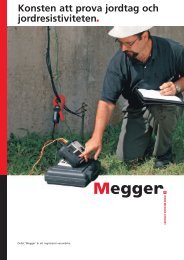A practical guide to earth resistance testing - Weschler Instruments
A practical guide to earth resistance testing - Weschler Instruments
A practical guide to earth resistance testing - Weschler Instruments
Create successful ePaper yourself
Turn your PDF publications into a flip-book with our unique Google optimized e-Paper software.
SECTION II<br />
Measuring Earth Resistance<br />
for Electrical Grounding Systems<br />
The simplest and somewhat misleading idea of a good ground for an<br />
electrical system is a section of iron pipe driven in<strong>to</strong> the <strong>earth</strong> with a wire<br />
conduc<strong>to</strong>r connected from the pipe <strong>to</strong> the electrical circuit (Fig. 6). This<br />
may, or may not, be a suitable low <strong>resistance</strong> path for electric current <strong>to</strong><br />
protect personnel and equipment.<br />
Lightning Rod<br />
Earth<br />
Plant Electric<br />
Wiring<br />
Electric<br />
Mo<strong>to</strong> r<br />
Electric<br />
Wire<br />
Earth Electr od e<br />
(Pipe driven in<strong>to</strong> g r ound )<br />
Fig. 6: A simplified grounding system in an industrial plant<br />
A <strong>practical</strong> <strong>earth</strong> electrode that provides a low ground <strong>resistance</strong> is not<br />
always easy <strong>to</strong> obtain. But from experience gained by others you can learn<br />
how <strong>to</strong> set up a reliable system and how <strong>to</strong> check the <strong>resistance</strong> value<br />
with reasonable accuracy. As you will see, <strong>earth</strong> resistivity (refer <strong>to</strong> Section<br />
I) has an important bearing on electrode <strong>resistance</strong>, as does the depth,<br />
size and shape of the electrode.<br />
The principles and methods of <strong>earth</strong> <strong>resistance</strong> <strong>testing</strong> covered in this<br />
section apply <strong>to</strong> lightning arrester installations as well as <strong>to</strong> other systems<br />
that require low <strong>resistance</strong> ground connections. Such tests are made in<br />
power-generating stations, electrical-distribution systems, industrial plants,<br />
and telecommunication systems.<br />
Fac<strong>to</strong>rs That Can Change Your Minimum Earth Resistance<br />
We will discuss later what value of <strong>earth</strong> <strong>resistance</strong> is considered low<br />
enough. You’ll see that there is no general rule usable for all cases. First,<br />
however, consider three fac<strong>to</strong>rs that can change the <strong>earth</strong> electrode<br />
requirements from year <strong>to</strong> year:<br />
n A plant or other electrical facility can expand in size. Also, new plants<br />
continue <strong>to</strong> be built larger and larger. Such changes create different<br />
needs in the <strong>earth</strong> electrode. What was formerly a suitably low <strong>earth</strong><br />
<strong>resistance</strong> can become an obsolete “standard.”<br />
n As facilities add more modern sensitive computer-controlled equipment,<br />
the problems of electrical noise is magnified. Noise that would not<br />
effect cruder, older equipment can cause daily problems with new<br />
equipment.<br />
n As more nonmetallic pipes and conduits are installed underground,<br />
such installations become less and less dependable as effective, low<strong>resistance</strong><br />
ground connections.<br />
n In many locations, the water table is gradually falling. In a year or so,<br />
<strong>earth</strong> electrode systems that formerly were effective may end up in dry<br />
<strong>earth</strong> of high <strong>resistance</strong>.<br />
These fac<strong>to</strong>rs emphasize the importance of a continuous, periodic<br />
program of <strong>earth</strong>-<strong>resistance</strong> <strong>testing</strong>. It is not enough <strong>to</strong> check the <strong>earth</strong><br />
<strong>resistance</strong> only at the time of installation.<br />
Some Basic Definitions<br />
First, let’s define our terms. As early as 1918 4 , the terms ground,<br />
permanent ground, and ground connections were defined <strong>to</strong> mean<br />
“electrical connections intentionally made between electrical bodies (or<br />
conducting bodies in close proximity <strong>to</strong> electrical circuits) and metallic<br />
bodies in the <strong>earth</strong> — such as rods, water pipes, plates, or driven pipes.”<br />
4 Reference 19 (see page 77)<br />
16 1-866-254-0962 www.megger.com Getting Down <strong>to</strong> Earth 17




